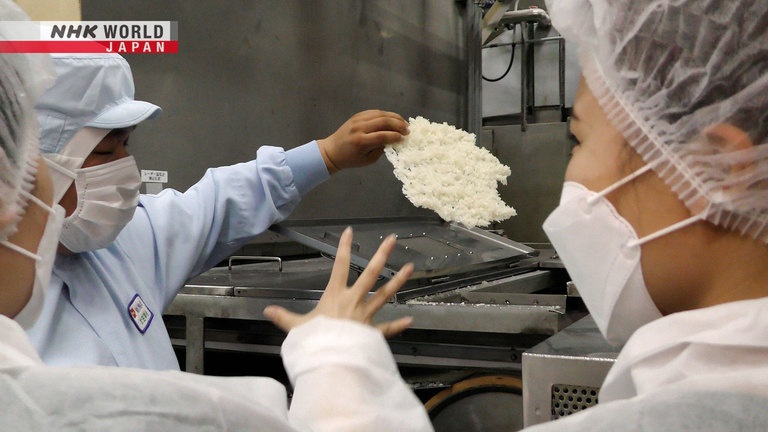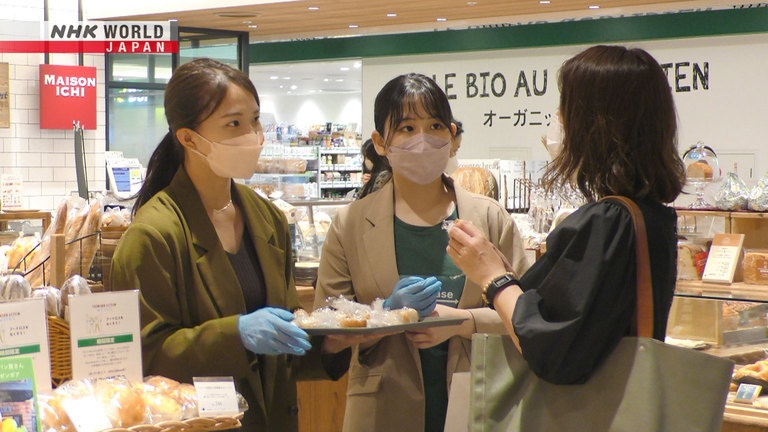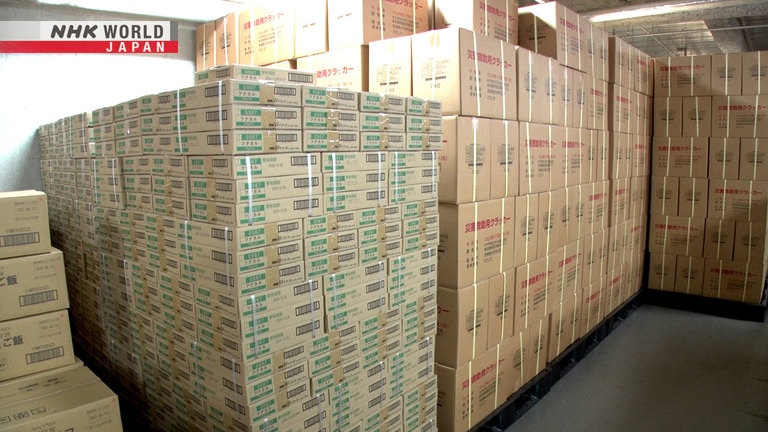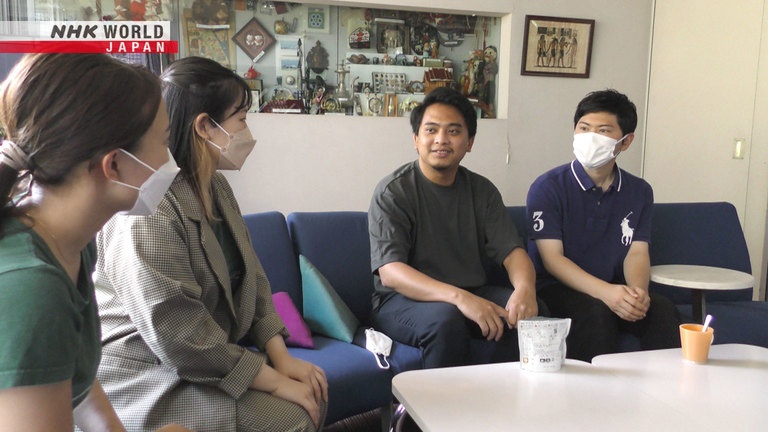Tackling Food Poverty with Rescued Rations: Social Business Founders - Seki Yoshimi & Kikuhara Misato
Since the Great East Japan Earthquake & Tsunami of 2011, Japan's market for emergency rations has skyrocketed. However, once purchased, most homes and workplaces forget about such supplies until their use-by date approaches, and they are ultimately thrown away. Yokohama college students Seki Yoshimi and Kikuhara Misato launched a social business that avoids such waste by leveraging these resources to tackle burgeoning food poverty that has been exacerbated by the COVID-19 pandemic.




Transcript
"RISING"
"Tackling Food Poverty with Rescued Rations"
Social Business Founders - Seki Yoshimi & Kikuhara Misato
In March 2011,
Japan was rocked by the Great East Japan Earthquake and tsunami.
Over 300 kilometers from the epicenter,
Tokyo too experienced power cuts,
rail delays and road gridlock,
leaving over 3.5 million commuters temporarily stranded.
Many were forced to spend the night in stations and other public facilities,
while convenience store shelves were quickly stripped bare of essential provisions,
prompting a nationwide reassessment of the importance of emergency rations.
The recommended minimum reserve is now three days of food and drink per person.
In years gone by,
such rations mostly amounted to dried biscuits and crackers.
But nowadays there are items like this freeze-dried vegetable pilaf.
Made with instant rice, it can be stored for up to five years
and easily rehydrated with hot or cold water
in the absence of power or gas.
And in the decade since March 2011,
the domestic market for emergency rations has almost doubled
to some 22 billion yen.
(Japan's emergency rations market)
We visited this multi-purpose high-rise in central Tokyo.
In case of emergencies,
the basement storeroom houses abundant rations for workers.
There's enough here for 100,000 meals.
Across Japan, many local governments instruct employers
to prepare at least three days' worth of rations per staff member.
This building has gone even further.
Besides the 1,000 plus regular workers,
they maintain sufficient rations for over 10,000 people
including visitors, customers and evacuees from the surrounding area.
But as with any such stockpile,
shelf life is a significant issue.
The building currently has some 26,000 cans of tuna
with only three months to go until their use-by date.
We can't simply contribute to food waste by throwing it all away,
so we've been giving it to local children's food initiatives and others in need.
But the sheer quantities involved here
mean that we've been unable to fully repurpose these supplies as we'd like.
It's a significant challenge for such a business
to identify and reach potential recipients with such resources.
According to one official study of prefectures
in the disaster-hit Tohoku region,
between 2015 and 2017, over 60%
of emergency rations were either partially or completely thrown away.
Yokohama, Kanagawa Prefecture.
Two individuals striving to eliminate wastage of emergency rations
are university students Seki Yoshimi and Kikuhara Misato.
In April 2021, they founded their own social business.
I think it's important to divide limited resources among various people.
It all started out from a desire to create a cycle
that reduces waste through redistribution.
The pair launched a website with a special online platform
that enables businesses to log an itemized list
of their surplus emergency rations
and the respective quantities.
They've just received a new entry.
So, six types of instant rice.
And its 72 boxes, with 50 packets in each box.
It adds up to 3,600 packets of food
with only one month of shelf life remaining.
It's not realistic to give them out to employees,
and they wouldn't want them anyway.
The registered rations are posted on the site,
where food aid initiatives and other potential users
can select the desired items and quantities for receipt, free of charge.
The concept of this matching service
is helping organizations with surplus rations
to reach those in greater need.
The provider pays shipping,
as well as a quantity-linked commission
to Seki and Kikuhara's company.
Back at the high-rise we visited earlier,
a recipient has been found for the soon-to-expire tinned tuna,
and a courier is here to pick it up.
From our standpoint, we really are extremely grateful
that this service helps us to identify potential recipients so quickly.
It really is an incredibly meaningful initiative.
And instead of paying disposal fees
to simply trash expired rations,
providers gain the opportunity to shift such expenses
into making a social contribution.
Nishinari Ward, Osaka.
One recipient of surplus rations from Seki and Kikuhara's service
is based in this social housing unit.
Those tomatoes are nice. So are the cucumbers.
The Nishinari Childcare Center works to support underprivileged local children.
Twice a week, they host a free dinner club.
Director Kawabe Yasuko
has been organizing such activities for more than two decades.
There really are a lot of children and families
who face significant hardship
in their day to day lives.
Kids get the chance to eat here at our dinner clubs,
but many parents also say
they wish we could spare some food for them to eat at home.
Through Seki and Kikuhara's service,
a delivery of unused emergency rations arrives from a major trading company.
3,000 rice-based instant meal packs.
And while the official best-before date is only a month away,
they're still perfectly edible.
Kids love dishes like chicken rice,
shrimp pilaf and dry curry.
And when food is short at home,
they can eat these just like instant noodles.
It can be a big help to have something in reserve
for moments like that.
So, as well as the chance to come here for twice-weekly home-cooked meals,
children are sent home with packs of instant rations
to supplement their families' diets.
Here you go. A little present.
Yay! Shrimp pilaf!
It's the perfect example of Seki and Kikuhara's matching service
effectively rescuing such emergency rations from disposal,
and delivering them to the people who need them most.
Only a year after its launch,
the service has already matched some 30 suppliers
with over 100 recipients,
delivering over 100 tons of rations in total.
The COVID-19 pandemic has also had an unexpected influence
on the nationwide ration surplus,
like at this major residential construction firm in Tokyo.
With a lot of employees now working from home,
low attendance has led us to reconsider
the amount of emergency rations we need to keep here.
The pandemic has seen daily in-person attendance at this company
fall significantly as people work from home.
Based on this new normal,
they've identified a surplus equivalent to three days' worth
of emergency rations for some 500 people.
It's all still perfectly edible,
so we'd feel very guilty to just throw it away.
But if we put it out and tell staff to help themselves,
we don't get that many takers.
And even if we resign ourselves to throwing it away,
the disposal costs are also very high.
In search of a solution,
the firm turned to Seki and Kikuhara's service.
And as a result, they've been able to free up space
and lighten their administrative burden.
There are always going to be fees
involved with delivering such supplies to the people who need them,
so it's only right that we as a company should shoulder such costs.
However, donated or otherwise,
there are some limits to the items recipients are willing to accept.
I was wondering if I could interest you in some bottled water
that a client is hoping to donate?
We have 255 boxes,
each containing 24 half-liter bottles.
Thank you very much for your time.
It's not looking good.
One provider has logged a large consignment
of soon-to-expire bottled water.
Most of our recipients are food aid charities,
so water isn't what they're looking for.
We need to work out the right approach.
While water is an essential emergency supply,
bulk and weight put most potential recipients off.
If possible, we'd like to donate some water to your university.
Instead of food-aid bodies, they reach out to a university.
We wondered if it might be of use to your sports clubs and so on.
Really? Thank you so much!
Yes! We got a bite.
When the site itself fails to throw up a match,
Seki and Kikuhara take the initiative.
This time, they've hit upon potential demand for water
among university sports teams.
We need recipients who are able to take large batches
with not much shelf life remaining,
so it can be tough to balance that supply and demand.
This student accommodation in Yokohama
is home to around 80 exchange students.
And with many such students feeling the pinch
amid the ongoing cost of living crisis,
today sees a delivery of 1,450 emergency meals.
Staff divide up the shipment for distribution to individual students.
Muhammad Ainun Fikiri
is a postgraduate student from Indonesia.
Have you tried emergency rations before?
No, this is my first time.
Wow, so they keep for five years?
He agrees to try this instant rice with wakame seaweed.
How does it taste?
Just like regular wakame rice!
You get hungry when you're working on your research at night,
so this is ideal for times like that.
As it heads into its second year,
the service is broadening the scope of people it helps.
Seki Yoshimi and Kikuhara Misato
are both in their fourth year at Yokohama City University,
where they met on a business start-up course.
Today, they're giving a talk to younger students
about their own experiences of setting up a business.
I was in the windsurfing club.
I spent all my time by the sea,
taking part in tournaments nationwide.
I never thought I'd start a business.
It was all just hanging out, club activities, working part time.
A typical college student.
I knew nothing about business etiquette or managing money.
The spark for these two unlikely entrepreneurs
came from their experiences volunteering as part of their course.
Their task was to distribute surplus calendars
produced by companies as promotional gifts to retirement homes.
And while at first they didn't expect many takers...
They weren't something we'd use,
so we thought it was natural to throw them away.
But rest home residents loved them.
That was a revelation to me.
They were surprised to even find numerous residents
queuing up to get first choice.
Among a generation unused to scheduling apps and technology,
calendars are a vital way of remembering when to take medicine and so on.
Between 300 residents,
they successfully gave out some 600 calendars.
That experience taught us that what some people see as waste
is probably of great use to somebody else.
We spoke to companies involved in the calendar project
to see what other kinds of surplus they had,
and that was when we first heard about all these stockpiles
of unused emergency rations.
They came up with a business model,
which won awards at multiple business contests,
convincing them to act on their plans and start a company of their own
with their combined prize money of 600,000 yen.
We didn't have some grand plan to change the world.
We just thought that our service could help solve a problem we'd seen for ourselves.
Of course we were nervous,
but we knew if we failed, it wasn't the end of the world
and that we could learn from that.
So we decided to go through with it.
Entering the second year of their service,
Seki and Kikuhara agree to take part in an event
at this department store.
The theme is products inspired
by the UN Sustainable Development Goals.
And Seki and Kikuhara have been invited to work
with this on-site bakery on a new use for emergency rations.
Some people have preconceptions about emergency rations
being something that gets handed out to underprivileged people,
and we want to try and dispel that.
These rations taste good enough to buy and eat as everyday products,
so we want to promote them as something people
would actively choose to consume.
With two weeks to go until the event,
the duo join a discussion about how best
to promote consumption of emergency rations.
They're joined by representatives of the department store,
and the CEO of the bakery they're working with,
as well as staff from an instant rice manufacturer.
My kids sometimes bring home surplus emergency rations from school,
including rice or wakame rice from your company.
But to be honest, we seldom get around to eating them.
As a maker of emergency rations,
of course lots of homes and so on keep a stock of our products,
but it's true that they often go uneaten.
So the question is, how can we change that?
We provide a lot of these items
to people who are struggling in their day-to-day lives,
but that alone is not enough to solve the issue of waste.
I think it would be fantastic if we could make them into something
that everybody actively chooses to eat.
They seize upon the potential of instant rice
as an ingredient for bread.
It's a great ingredient. Easy to store.
It's dried, so there's no need for refrigeration.
And you don't need to worry about mold.
As a company, we hope that
this can be a spark for future sustainability,
and that events to promote better understanding of emergency rations
can become a more regular occurrence.
The team gets down to work on developing new baked goods.
They're using this white instant rice.
The plan is to use rehydrated rice grains
alongside wheat flour to create a bread with sales potential.
They begin by adding the rehydrated rice
to a standard wheat flour-based dough.
To emphasize the fact that this bread uses rice,
we've adjusted the quantities to leave visible rice grains.
Without enough of those, you'd lose the impact of instant rice bread.
But we don't want too many of them either.
The challenge lies in finding the right balance of bread dough
and rice to achieve a pleasing texture.
Osaki, Miyagi Prefecture
is among Japan's leading rice producing regions.
It's also the site of this instant rice factory.
- Good morning!
- Good morning!
This producer commands 70% of Japan's instant rice market.
First, we steam the rice for 30 minutes.
Far from some special variety,
the process uses typical Japanese table rice.
But rather than cooking it in vats or pans,
they steam it to ensure the best possible texture.
Next, this special apparatus is used to rapidly dry the grains.
It comes out in sheets like this.
- Wow!
- Wow!
So, this is instant rice!
The end result is soon ready to eat,
simply by rehydrating with hot or cold water.
Is instant rice lighter than uncooked rice?
It's pretty light.
Uncooked rice has a water content of 15%,
and we get that down to just 9%.
Wow, less than 10% water.
So even if microbes are present,
there's not enough moisture for them to survive.
And because microbes can't reproduce,
you can store it for long periods.
Storable for five years or more
without the use of any artificial preservatives,
it's perfect for emergency rations.
This firm combines this rice with freeze-dried vegetables
and other ingredients for mixed rice dishes and instant dry curries.
How many boxes do you ship per day?
Up to 3,000 or so.
And they also maintain a stockpile of some two million meals
to distribute in times of emergency.
We're ready to mobilize in case of natural disasters.
But of course, if there are no disasters,
shelf life becomes an issue.
So that's a major concern for us.
So as both producer and surplus creator,
this manufacturer has high hopes for Seki and Kikuhara's initiative.
You can rely on the younger generation
for the kind of novel ideas that show the way forward.
As a business, it's inspiring to receive input
that we wouldn't have come up with by ourselves.
Meanwhile, back at the bakery,
the instant rice bread prototype is ready.
After trial and error,
the ideal balance uses 40% instant rice.
Crunchy grains are clearly visibly on the browned outer crust.
And to showcase the bread's chewy texture,
they settled on plain white rolls.
The day of the launch arrives.
The new product will be on sale for two weeks.
But will customers take to this instant rice-based bread?
Seki and Kikuhara are here in person to give out samples.
This bread uses instant rice from emergency rations.
Oh, the stuff you throw away when it expires?
It has a nice springy texture,
not like rice bread at all.
It's very nice.
Nice and soft and airy,
with a lovely chewiness as you bite in.
- Right?
- Yes, nice and soft.
In order to reduce waste of instant rice
as it reaches its use-by date,
we've mixed it with wheat flour here.
It is a shame to throw emergency rations away.
But their shelf life is so long
that you just tend to forget all about them.
So I think it's really great
that you've found a way to reuse them.
The instant rice bread quickly flies off the racks.
And for Seki Yoshimi and Kikuhara Misato,
it's just another step in their mission
to reduce waste of emergency rations.
We've proved that bringing added value to instant rice
can raise its profile with a larger audience.
And for me, that potential appeal
has been the big take home from this experience.
If you want consumers to eat these foods,
rather than talking about food waste,
the main question is, does it taste good?
So moving forward, that broader appeal has to be the key focus.